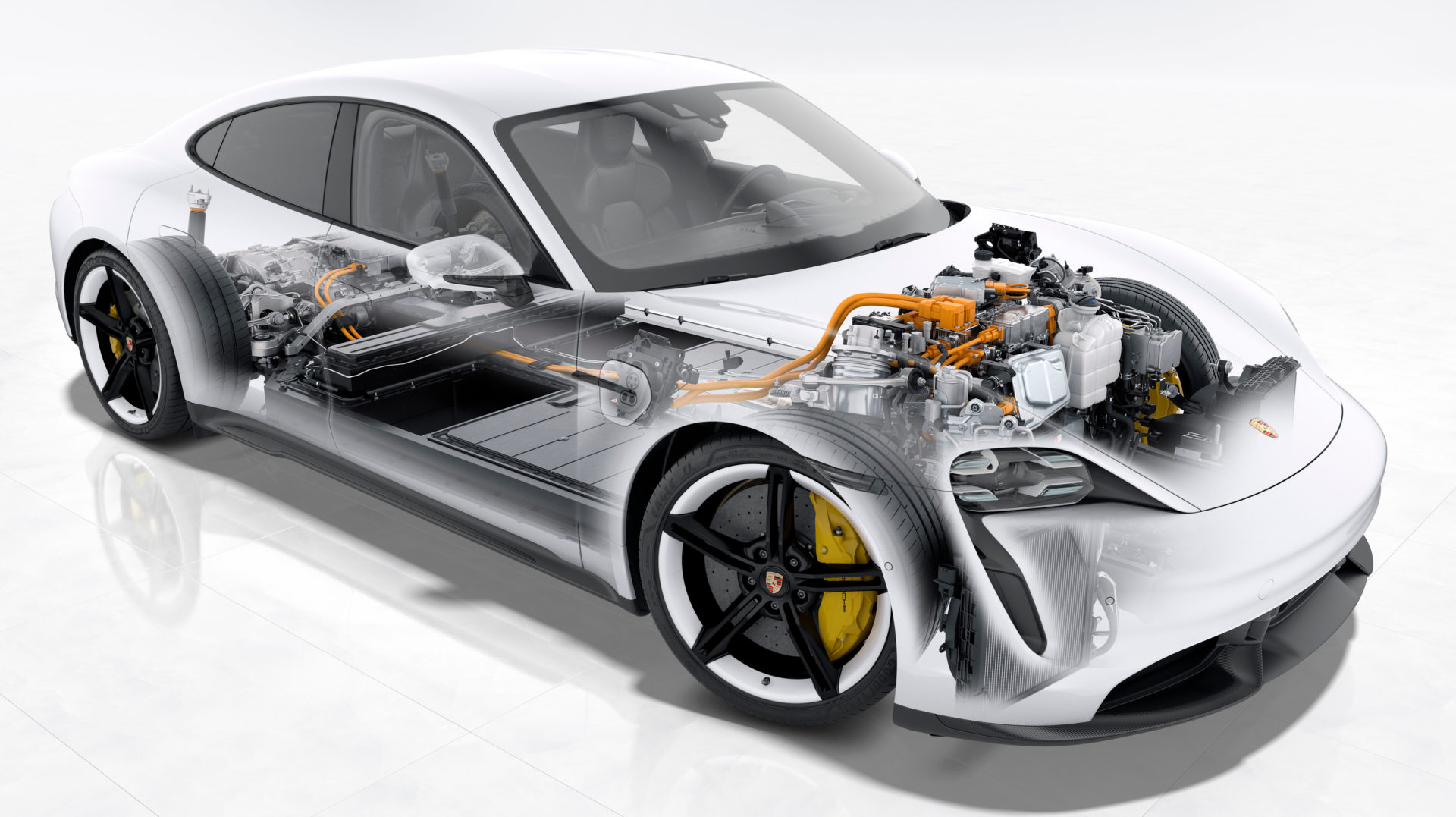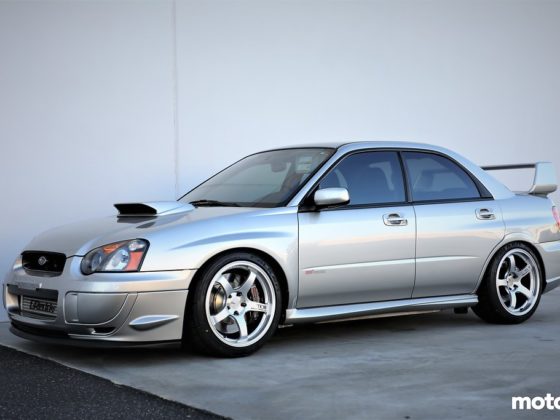
Some other little meaningful features Porsche touts is the shape of the copper wires in the motors. To maximize the power density of an electric motor, as much copper as possible needs to be crammed in. To cram in more copper, square wire is used instead of round. I used some masterful Power Point shapes to illustrate the better utilization of space of the square wires.

You may be asking, what do I think is the best battery cooling scheme out there right now? Of what’s public knowledge, I’d go with Rivian’s concept of a cooling plate at the base of cylindrical cells. You’re going to point out to me that the contact surface area is low because it’s just the bottom of the cell touching the cooling plate and you’d be correct. Here’s the thing however, the conduction heat transfer coefficient for a li-ion cylindrical battery cell is not the same in all directions. It turns out, the conduction heat transfer coefficient is much better axially compared to radially. Tesla is getting heat out on the circumference of the cell, so radially. The cooling plate concept that Rivian has shown is grabbing the heat in the axial direction. So even for the same contact surface area, a lot more heat can be pulled out of the cylindrical battery cell from the bottom.

An important performance metric when it comes to EVs is range. The Taycan’s rated range is not impressive for the battery pack capacity; i.e. it has poor efficiency. Elon Musk has rightfully boasted that the competition’s modern EVs can’t even compete with the first-generation Model S in efficiency. The Taycan has a stated low coefficient of drag. So why the mediocre efficiency? One part of the puzzle could be the tires. Porsche makes track cars and fitted appropriate track size tires to the Taycan. The Taycan Turbo S rides on 305 wide tires compared to the Model S on 245s. For reference, on Project S2000, when I went from the stock 215/245 (front/rear) high performance summer tires to 245 wide all around on max performance summer tires, my highway mpg dropped from 29 to 24. On my hybrid DD, my fuel economy dropped 7% going from the stock Michelin eco-garbage tires to Bridgestone RE970s ultra high performance all-seasons. Yeah, tire selection has a drastic impact on range.
Has Porsche made a step change in EV performance? I believe they have. Tesla made EVs fast and gave them range. Porsche has taken the next step and made an EV that can handle sustained high-power usage, whether that be driving quickly or charging quickly. Don’t forget that Porsche came out with the 918 in 2013. The 919 started racing in 2014. Porsche definitely has some background in high performance powertrains involving batteries and high power electronics. The Taycan has already laid down an impressive lap at the Nurburgring. Once they hit the streets, we will see how it does in the real world in the hands of normal owners.




17 comments
I think aluminium ammonia heat pipes are going to be a big part of high density battery cooling (if they aren’t already). They are light, safe, and proven. They can be easily shaped and fitted, plus, the materials are cheap and recyclable.
Pouch/prismatic cells are also much easier to heat and cool than cylinder cells although I wonder how Porsche deals with gas swell in the pouches.
I came up with something along those lines already….
https://patents.google.com/patent/US10153524B2/en?oq=US10153524B2
I didn’t know you worked at Faraday Future! What other places have you worked at and keeping from us!?
I knew others must have thought of heat pipes, they have been used to cool all kinds of electronics and aluminium ammonia pipes have been used for decades to cool spacecrafts and military avionics.
I was thinking about moving heat to a water radiator right next to the cells then cool the water with a standard radiator, yours skips water completely which is great for weight sounds like a nightmare to manufacture/service unless you are transferring heat from pipe to pipe in shorter sections or using individual radiators.
Heat pipe manifolds, that’s probably the more novel idea hahaha.
Just think of it as an A/C system. Condenser (front radiator), evaporator (heat source/battery pack), and refrigerant running between the two. All established technologies for decades. Honestly, take this i3/Taycan cooling plate which is already designed for refrigerant. Just plumb it to a standard front automotive A/C condenser and you’re done for a 100% passive cooling system. Now to sub cool below ambient and to handle high power loads, you’d need to add the chiller. Say the pack is cooler than ambient and you don’t want to heat it up, just put some solenoids in the lines to cut the flow of refrigerant. If you want to heat up the pack, could run the compressor like a heat pump in residential applications. Anyway… I’m out of automotive now for the day job. Using heat pipes in my current job!
Porsche uses a chiller for the Taycan.
It already uses one for all the last e-hybrid models !
The schematic used here is just a simple representation of the battery cooling.
It’s allready much better than that in the e-hybrid models.
For the Taycan and range/charging option, Porsche has a range simulator online and shows the charging options too.
A Ionity charger will charge a Taycan in 30min for 8€ in Europe.
The range is not the greatest or most impressive, but most Porsche owners won’t really need more. And with the network of ionity chargers, and “destination charging” stations (luxury places and Porsche centers that have an agreement with Porsche and Turbo-chargers available for charging Taycans at 350Kw for free), range won’t be a problem.
One option will be critical for Taycan owner : Getting the Connect service which will unlock a lot of functions very useful for long trips (Charging planners the pre-conditions the battery for fast charging prior to arrival at the charging station etc…).
As a Porsche Tech / Hybrid Tech / Smart Mobility Expert I’m more worried about the 4 screens failing inside than the reliability or longevity of the powertrain !
Ben, thanks for the info! It’ll be interesting to see what’s in there for real once that information becomes available. No joke about all those screens!
I found a picture from my last hybrid training of an opened 388v Panamera E-hybrid batterie.
https://i53.servimg.com/u/f53/13/27/76/86/img_7631.jpg
You can see that the cooling system is already very intricate !
All the black strip are the wiring for the individual cells, with temp sensors etc.
Thanks for the link of pic. Looks like two layers of prismatic cells with 3 layers of cooling plates. I feel bad for the engineers that had to do the coolant plumbing!
so this thing gets a double wishbone suspension but the Cayman and 911 have to make do with the McCrap strut…
Excellent article. Well written and great presentation of information. I think the Taycan seems like a logical step up from the now 8yr old Model S, but at what cost? I still haven’t heard a peep about Taycan MaRP which usually means it’s ludicrously expensive. I’d be shocked if it wasn’t 50% more expensive than the closest equivalent model S.
It’ll be between $150k-$200k depending on the model. Keep in mind that’s how much the Panamera goes for. If I had the money, I’d go Taycan all day over the Tesla. I really dislike the Tesla interiors. But, I don’t even have Tesla Model 3 money….. so mute subject, ha!
Super interesting article, however I think your explanation of Ohmic heating being reduced with higher pack voltage is misleading. For a fixed cell, series/parallel configuration doesn’t affect loss in a battery pack, only cell count and total output/input power (at least when it comes to ohmic losses within the cells themselves). You somewhat hint at this “okay that really isn’t the whole picture”, but as far as I can tell that isn’t the picture at all. I^2 numbers are meaningless without the R. If Porsche took the same pouch cells and arranged them in a 400V pack architecture, their loss would be the same at a given output or charging power. I think the main source of increased performance (which you allude to) is decrease ESR of the pouch cells. They most likely traded absolute capacity for performance (thicker anode/cathode, etc.). Regardless, a super interesting and informative read as usual!
Hey Derek! You’re right… I came to the same conclusion about the ESR. I was writing a bit stream of consciousness, and I was like, I’m missing something… Would be nice to break down a pack and take real measurements. Hope you’re doing well up there!
I hope that Porsche doesn’t forget the Arctuc silver thermal paste! Or is that for the next-gen Taycan (sorry, that name still gives me the shivers.)
https://www.newegg.com/arctic-silver-as5-3-5g/p/N82E16835100007
Will ‘enthusiasts’ be hacking the cooling system and pumping LN2 through it? Don’t say it can’t be done.
https://www.stirlingcryogenics.eu/en/products/custom-closed-loop-cooling-systems/closed-loop-liquid-nitrogen-cooling-systems
A good ole water sprayer on the condenser would help!
Kindly notify me on the latest EV battery technology design and longest range capability